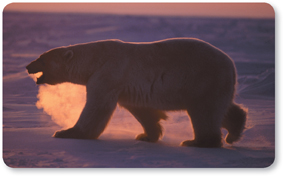27.2 Respiration
 What characteristics do the respiratory structures of all animals share?
What characteristics do the respiratory structures of all animals share? How do aquatic animals breathe?
How do aquatic animals breathe? What respiratory structures enable land animals to breathe?
What respiratory structures enable land animals to breathe?
gill • lung • alveolus
Concept Map Draw a concept map showing the characteristics of the lung structures of vertebrates.
THINK ABOUT IT All animal tissues require oxygen for respiration and produce carbon dioxide as a waste product. For that reason, all animals must obtain oxygen from their environment and release carbon dioxide. In other words, all animals need to “breathe.” Humans can drown because our lungs can't extract the oxygen we need from water. Most fishes have the opposite problem; out of water, their gills don't work. How are these different respiratory systems adapted to their different functions?
Gas Exchange
 What characteristics do the respiratory structures of all animals share?
What characteristics do the respiratory structures of all animals share?
Despite all the amazing things living cells can do, none can actively pump oxygen or carbon dioxide across membranes. Yet, in order to breathe, all animals must exchange oxygen and carbon dioxide with their surroundings. How do they do it? Animals have evolved respiratory structures that promote the movement of these gases in the required directions by passive diffusion.
Gas Diffusion and Membranes As you may recall, substances diffuse from an area of higher concentration to an area of lower concentration. Gases diffuse most efficiently across a thin, moist membrane that is permeable to those gases. The larger the surface area of that membrane, the more diffusion can take place, just as a bumpy paper towel absorbs more liquid than a smooth one does. These physical principles create a set of requirements that respiratory systems must meet, one way or another.
Requirements for Respiration Because of the behavior of gases, all respiratory systems share certain basic characteristics.  Respiratory structures provide a large surface area of moist, selectively permeable membrane. Respiratory structures maintain a difference in the relative concentrations of oxygen and carbon dioxide on either side of the respiratory membrane, promoting diffusion.
Respiratory structures provide a large surface area of moist, selectively permeable membrane. Respiratory structures maintain a difference in the relative concentrations of oxygen and carbon dioxide on either side of the respiratory membrane, promoting diffusion.

FIGURE 27–5 Requirements for Respiration Respiratory surfaces are moist, so exhaled air contains a lot of moisture. That exhaled moisture condenses into visible “fog“ if outside air is cold.

Table of Contents
- Formulas and Equations
- Applying Formulas and Equations
- Mean, Median, and Mode
- Estimation
- Using Measurements in Calculations
- Effects of Measurement Errors
- Accuracy
- Precision
- Comparing Accuracy and Precision
- Significant Figures
- Calculating With Significant Figures
- Scientific Notation
- Calculating With Scientific Notation
- Dimensional Analysis
- Applying Dimensional Analysis




